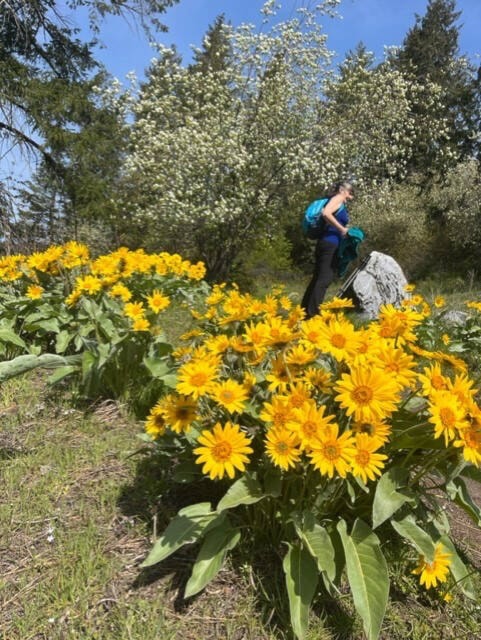Roseanne Van Ee
The Okanagan91ÂãÁÄÊÓƵ™s Nature Nut
Our hills come alive in spring with flamboyant wild sunflowers amid profuse white-blossomed Saskatoon bushes.
Numerous sensational arrow-leaved balsamroot (a.k.a. wild or spring sunflower) bouquets of big, bright yellow flowers create spectacular colourful shows on warm, dry, undeveloped open hillside slopes throughout the valley in April and May. This showy perennial resembles clusters of sunflowers in bloom growing 30-45 centimetres tall from a thick deep taproot with many large, silvery, felted, arrow-shaped leaves. The woody taproot has a pitchy balsam-like smell.
Before European settlement, wild sunflowers were so plentiful that they provided an important versatile food source for the original First Nations Okanagan people when most other vegetation was still unavailable. The Okanagan people dug up the carrot-sized taproots in spring and pit-steamed them. Some people ate the shoots, flower buds or young leaf stalks raw early in spring.
Then, in late summer they shook out the miniature sunflower seeds from the dried heads to sun dry or roast, or pound up to mix with berries or fat. They also used the large, supple, felty leaves as lids on their bark or root baskets when picking berries, bulbs or roots. Deer and elk graze them, too. A concoction was made from balsamroot to counteract poison ivy reactions.
Saskatoon shrubs (a.k.a. service or June berry), alive with splashy, showy white, clustered blossoms in April and May, cover the hillsides along with the wild sunflower bouquets. Later, the plentiful purple to dark blue sweet, ripe blueberry-like berries are a real treat for people, bears and birds. While deer and elk browse on Saskatoon bushes throughout winter.
The shrubs grow one to seven metres tall. 91ÂãÁÄÊÓƵ˜Saskatoon91ÂãÁÄÊÓƵ™ may be an Anglicized version of the Blackfoot name for this bush 91ÂãÁÄÊÓƵ˜mis-ask-a-tomina91ÂãÁÄÊÓƵ™ meaning 91ÂãÁÄÊÓƵ˜fruit of the tree of many branches.91ÂãÁÄÊÓƵ™ The berries91ÂãÁÄÊÓƵ™ size, texture and taste can vary from plant to plant. If you see prickly-pear cactus blooming in June or July, the Saskatoon berries should be ready to pick.
The original Okanagan people had a myriad of uses for these plentiful berries. They enjoyed them freshly picked; a real treat for children. They often mashed and dried them into fruit leather. But many were dried to use in soups and stews, or used as a sweetener with other foods or rehydrated later. And the dried berries were a popular trade item with coastal people.
You can pick Saskatoons to eat fresh or add to muffins, pancakes, puddings and pies, or make delicious jams or syrup. Swallow their small seeds or spit them out. I enjoy picking them. And any that I don91ÂãÁÄÊÓƵ™t eat fresh I collect to freeze on cookie sheets then store in yogurt containers for later use. They91ÂãÁÄÊÓƵ™re delicious canned too. My favourite is canned Saskatoons with French vanilla ice cream in February.
I also love making no bake Saskatoon pie:
Pour 1 cup fresh berries into a graham cracker pie crust
Cover another cup of Saskatoon berries in water in a pot with 2 tablespoons of corn starch, cook and stir until the juice is clear (not cloudy). Adding sugar is optional
Pour this over the pieshell berries and let cool
Top with whipped cream, Greek yogurt or French vanilla ice cream
You can easily propagate Saskatoons from wild seedlings or rooted cuttings for a dashing spring display and copious summer berries. This is a tremendous way to rewild/naturescape your yard to attract native pollinators and provide food for wild birds and butterflies, and for yourself. I can hardly wait for our hillsides to spring back to life. Can you?
Roseanne Van Ee enthusiastically shares her knowledge of the outdoors to help readers experience and enjoy nature. Follow her on Facebook for more.
READ MORE: Over 500 species of mushrooms documented in B.C.
READ MORE:
newsroom@vernonmorningstar.com
Like us on and follow us on



